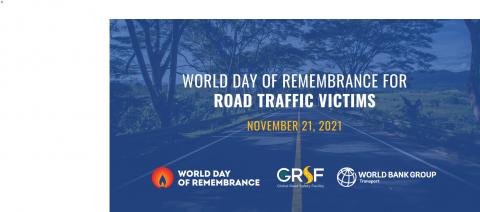Thoughts on World Day of Remembrance for Road Traffic Victims 2021

Today, the third Sunday of November, as done over the past 20 years, we commemorate the World Day of Remembrance for Road Traffic Victims (WDoR) to remember those who died or were severely injured in a road crash.
Unacceptable Human Toll of Traffic Injuries
The unfortunate reality is that these tragic events are a daily occurrence across the world. Data from the World Health Organization (WHO) show that approximately 1.3 million people are killed on the world’s roads each year, and another 20-50 million more people suffer non-fatal injuries, with many incurring a disability as a result of their injury. Global estimates also indicate that 79.6 million healthy years of life are lost annually due to traffic injuries. Global Burden of Disease and Injuries data for 2019 show that road injuries were the leading causes of death for ages 10–24 and among the 25–49 age group, negatively impacting both males and females.
Road injuries have also a substantial impact on maternal and child health. Health loss attributable to motorized road transport exceeds that from key risk factors affecting children, including childhood underweight and suboptimal breastfeeding. Road injuries rank among the top 10 causes of death after the first year of life through age 59. In addition, road injuries are a top-10 cause of death among women of childbearing age and are the fourth-leading cause among women aged 15 to 29 years.
Combined with the deaths arising from vehicle pollution, the road transport death toll exceeds that of, for example, HIV/AIDS, tuberculosis, malaria, diabetes, or COVID-19 disease.
Preventable High Economic Toll
The above figures clearly convey the undeniable fact that much human potential is being lost unnecessarily due to traffic injuries. Beyond the enormous suffering they cause, as vividly captured in the devastating stories of people whose lives are ruined or never fully realized because of injuries, premature death and long-lasting disabilities, the economic cost of traffic injuries and death are also unacceptably high measured in terms of loss of household earnings when a breadwinner dies, costly trauma care and rehabilitation services, damage to vehicles and property, and insurance and disability pay-outs.
Besides preventing loss of life of people, and the resulting pain and misery bestowed on families and communities, there are significant long-term economic gains to be achieved from the adoption of simple, sustainable, affordable and effective traffic safety policies and interventions. As documented in a World Bank Group report, “The High Toll of Traffic Injuries: Unacceptable and Preventable”, prepared with the support of Bloomberg Philanthropies, that assesses both the potential economic growth benefits and aggregated social welfare gains from long-term reduction of traffic injuries and deaths in low- and middle-income countries (LMICs), focusing on an initial set of five countries (China, India, Philippines, Tanzania, and Thailand), the estimated impact ranges from a 7 to 22 percent increase in GDP per capita over 24 years. This finding is a clear message to governments: there is a significant economic loss associated with every year of inaction where LMICs fail to adopt effective policies and interventions to substantially reduce road traffic injuries and deaths.
The effect on national income growth, however, is only a part of the story. Since the intangible value society assigns to health is not captured in the income growth effect estimates, the World Bank Group report presents estimates of the enormous welfare benefits associated with what it would be worth to people to reduce the risk of road traffic injuries and deaths. Using value of statistical life (VSL) measures—the monetary value assigned for statistical purposes on a life saved through a policy measure—the report shows that estimated additional welfare benefits equivalent to 6 to 32 percent of the national GDP can be realized from reducing 50 percent of road traffic injuries and deaths over a period of 24 years.
What to Do?
There is a growing body of accumulated evidence on “what works and what does not work” in road safety. Indeed, a variety of road user-based interventions have been implemented over many years across countries, such as speed limits, seat belts, and cycle helmets, which do reduce traffic deaths and injuries. This year, WDoR 2021, puts the spotlight on the reduction of traffic speeds, which has the potential to prevent many deaths and serious injuries, in particular those of pedestrians and all other vulnerable road users including children, the elderly, and persons with disabilities.
However, many low- and middle-income countries, where the vast majority of traffic crashes and deaths occur, often lack the expertise and support they need to tackle key road safety risks: weak and inadequate road safety laws; limited police enforcement of existing laws, including to prevent drink-driving; minimal or nonexistent vehicle safety standards; streets designed solely for vehicle use that fail to consider other road users like pedestrians; and well-designed and integrated emergency medical care services, both pre-hospital and in-hospital.
Preventing and mitigating the risks from traffic injuries, therefore, requires a long-term investment strategy to build the capacity of national institutions so they can actively manage safety and mobility performance through targeted interventions. This is necessary given the multisectoral complexity of road safety and demands a systematic approach rather than isolated efforts with specific sectoral interventions.
Initiatives, such as the World Bank’s Global Road Safety Facility (GRSF), have been responding to the global road safety crisis through funding, capacity building, communications, technical assistance, and advocacy, and are committed to creating a safer road environment for all. Following a “Safe System” approach, support is geared to:
- Strengthening institutional capacity to further national road safety efforts, including activities such as establishing a lead agency for road safety in the country involving partners from a range of sectors and developing a national road safety strategy.
- Influencing safety road design and network management to make roads safer for users, particularly the vulnerable (pedestrians, cyclists, children, the elderly, bus passengers) and reducing severity of crashes.
- Making vehicles safer by adopting motor vehicle safety standards; implementing new car safety assessment programs; and ensuring that all new cars are equipped with seat belts that meet regulatory requirements and pass applicable crash test standards.
- Influencing road user behavior through sustained enforcement of road traffic laws and standards and rules combined with public awareness/education activities.
- Integrating and improving Emergency Medical Services to care for the injured at the scene of the accident and transport them in ambulances or rescue helicopters to hospitals and clinics following standardized protocols in the health system—a pre-hospital screening process helps prevent further loss of life by determining the appropriate health facility to transport patients to, rather than sending them to the nearest facility which might not be able to offer needed care.
Rapidly scaling up road safety programs alongside the expansion of transport is vital for saving lives while promoting development, including critical areas such as the strengthening of supply chains to move goods across and within countries as we are now observing during the COVID-19 pandemic.
Looking ahead
The prevention of traffic injuries and premature deaths, under multisectoral partnerships and investments, will pay off in terms of healthy life years, free of injuries and disabilities. This, in turn, will contribute to build health capital (the value of a person’s lifetime health) and hence, human capital (the sum of knowledge, skills, and know-how possessed by the population), which increasingly are the main source of a country’s total wealth and long-term success (human capital, estimated as the present value of future earnings for the labor force, employed and self-employed, is the largest asset across all income groups, constituting 64 percent of total wealth in 2018).
As we enter a new year, let’s renew our commitment across sectors to help confront “death on wheels” as one of the most significant preventable global public health threats of the early 21st Century. In doing so, let’s be clear that we are not pursuing only a public health goal, but more importantly, a broad social goal that impacts all of us, since the reduction of preventable traffic injuries and deaths is a key requirement for building healthy and resilient societies, dynamic and innovative economies, and the growth of living standards.
Credits for images:
-
First image: Image from the World Bank Group Global Road Safety Facility
-
Second image: Royalty-free stock photo ID: 1721662801. On the Car Crash Traffic Accident Scene: Rescue Team of Firefighters Pull Female Victim out of Rollover Vehicle, They Use Stretchers Carefully, Hand Her Over to Paramedics who Perform First Aid. By Gorodenkoff

